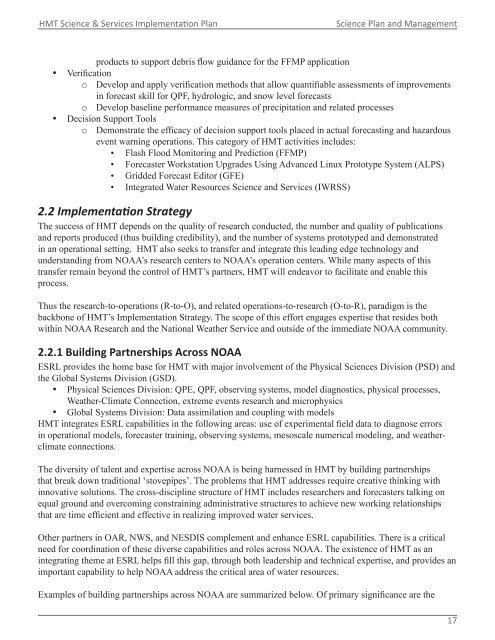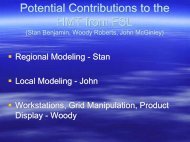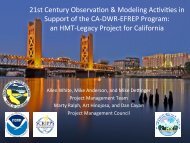Hydrometeorology Testbed (HMT) Program - NOAA ...
Hydrometeorology Testbed (HMT) Program - NOAA ...
Hydrometeorology Testbed (HMT) Program - NOAA ...
Create successful ePaper yourself
Turn your PDF publications into a flip-book with our unique Google optimized e-Paper software.
<strong>HMT</strong> Science & Services Implementation Plan Science Plan and Management<br />
products to support debris flow guidance for the FFMP application<br />
• Verification<br />
o Develop and apply verification methods that allow quantifiable assessments of improvements<br />
in forecast skill for QPF, hydrologic, and snow level forecasts<br />
o Develop baseline performance measures of precipitation and related processes<br />
• Decision Support Tools<br />
o Demonstrate the efficacy of decision support tools placed in actual forecasting and hazardous<br />
event warning operations. This category of <strong>HMT</strong> activities includes:<br />
• Flash Flood Monitoring and Prediction (FFMP)<br />
• Forecaster Workstation Upgrades Using Advanced Linux Prototype System (ALPS)<br />
• Gridded Forecast Editor (GFE)<br />
• Integrated Water Resources Science and Services (IWRSS)<br />
2.2 Implementation Strategy<br />
The success of <strong>HMT</strong> depends on the quality of research conducted, the number and quality of publications<br />
and reports produced (thus building credibility), and the number of systems prototyped and demonstrated<br />
in an operational setting. <strong>HMT</strong> also seeks to transfer and integrate this leading edge technology and<br />
understanding from <strong>NOAA</strong>’s research centers to <strong>NOAA</strong>’s operation centers. While many aspects of this<br />
transfer remain beyond the control of <strong>HMT</strong>’s partners, <strong>HMT</strong> will endeavor to facilitate and enable this<br />
process.<br />
Thus the research-to-operations (R-to-O), and related operations-to-research (O-to-R), paradigm is the<br />
backbone of <strong>HMT</strong>’s Implementation Strategy. The scope of this effort engages expertise that resides both<br />
within <strong>NOAA</strong> Research and the National Weather Service and outside of the immediate <strong>NOAA</strong> community.<br />
2.2.1 Building Partnerships Across <strong>NOAA</strong><br />
ESRL provides the home base for <strong>HMT</strong> with major involvement of the Physical Sciences Division (PSD) and<br />
the Global Systems Division (GSD).<br />
• Physical Sciences Division: QPE, QPF, observing systems, model diagnostics, physical processes,<br />
Weather-Climate Connection, extreme events research and microphysics<br />
• Global Systems Division: Data assimilation and coupling with models<br />
<strong>HMT</strong> integrates ESRL capabilities in the following areas: use of experimental field data to diagnose errors<br />
in operational models, forecaster training, observing systems, mesoscale numerical modeling, and weatherclimate<br />
connections.<br />
The diversity of talent and expertise across <strong>NOAA</strong> is being harnessed in <strong>HMT</strong> by building partnerships<br />
that break down traditional ‘stovepipes’. The problems that <strong>HMT</strong> addresses require creative thinking with<br />
innovative solutions. The cross-discipline structure of <strong>HMT</strong> includes researchers and forecasters talking on<br />
equal ground and overcoming constraining administrative structures to achieve new working relationships<br />
that are time efficient and effective in realizing improved water services.<br />
Other partners in OAR, NWS, and NESDIS complement and enhance ESRL capabilities. There is a critical<br />
need for coordination of these diverse capabilities and roles across <strong>NOAA</strong>. The existence of <strong>HMT</strong> as an<br />
integrating theme at ESRL helps fill this gap, through both leadership and technical expertise, and provides an<br />
important capability to help <strong>NOAA</strong> address the critical area of water resources.<br />
Examples of building partnerships across <strong>NOAA</strong> are summarized below. Of primary significance are the<br />
17






